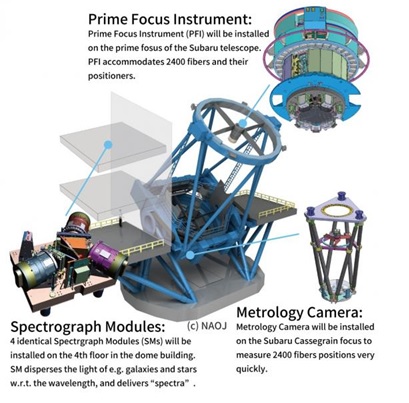
The PFS (Prime Focus Spectrograph) project is developing an ultra wide-field, highly-multiplexed spectrometer for the Subaru telescope as one of its next-generation instruments. The instrument deploys robotic positioners at the telescope prime focus to accurately place ~2400 optical fibers on astronomical objects over the hexagonal field of view with a circumscribed circle’s diameter of 1.38 degrees. Then the lights from these objects are transmitted to a spectrograph system that delivers the same number of spectra over a wide range of wavelengths from 380nm to 1260nm (namely, the entire range of visible light plus a part of near-infrared light) in one exposure. The combination of the Subaru telescope and PFS is really unique: On top of the large light-gathering power by the 8.2m-diameter primary mirror and the ultra wide field of view at the prime focus, the PFS’s multiplicity and wide wavelength coverage are integrated. PFS on the Subaru telescope is therefore a powerful suite that can carry out large spectroscopic survey with a greater speed by a large factor than similar, competitive instruments on other large telescopes.
The PFS project is promoted by an international collaboration of more than 10 research institutes over 7 countries, and the Kavli IPMU is taking its initiative: Principal Investigator Hitoshi Murayama (former Kavli IPMU director), Principal Investigator Masahiro Takada, and Associate Professor Naoyuki Tamura are playing the central roles in the PFS project as Principal Investigator, Project Scientist, and Project Manager, respectively, and are leading the activities with other Kavli IPMU members of the instrument development and the large survey observation planning that spans for ~300 nights over ~5 years. The instrument development has been in an exciting phase: One of the subsystems, Metrology Camera, was shipped to the Subaru telescope on Maunakea in Hawaii in 2018, and was successfully tested on the telescope through the two nighttime engineering runs, one in October 2018 and the other in August 2019. Furthermore, in October 2019, the first spectrograph module departed the development site in France, and the integration was successfully completed at the telescope site by the work in December 2019. We aim to start nighttime on-sky engineering observations in 2020, and survey observations of scientific use in 2022.
(Last update: 2020/01/06)
Links
- Observational Cosmology
- Structure Formation
- Detector/Instrument Development
- PFS official web site
- PFS blog






